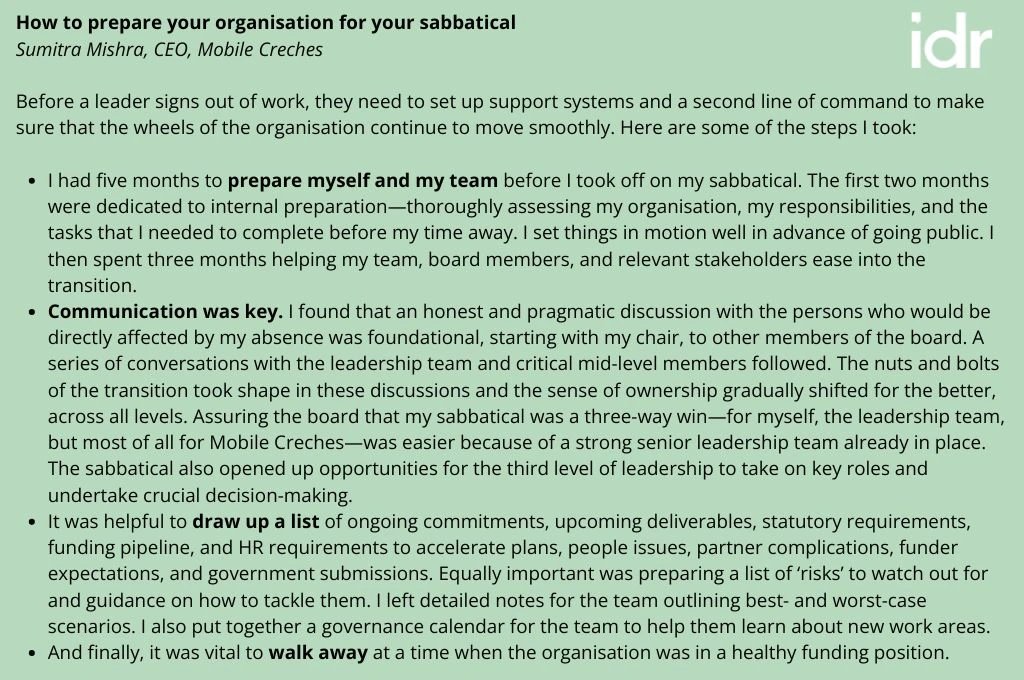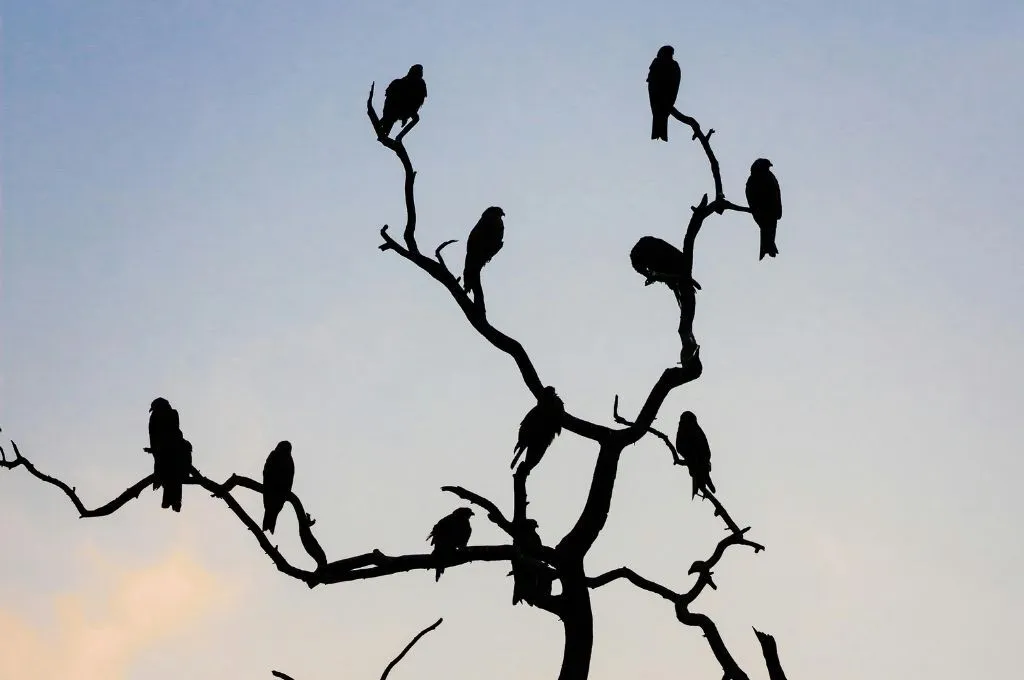“I am experiencing what slowing down feels like. It feels beautiful.”
Slowing down, taking a pause, feeling centred, gaining clarity, discovering delight, reviving relationships, rediscovering oneself—these were some of the experiences reported by development sector leaders who returned from a recent sabbatical. They were part of the first cohort of The Cocoon Initiative, a paid sabbatical programme launched in November 2023. The programme offers heads of nonprofits an opportunity to temporarily withdraw from the grinding demands of development work and simply rest.
Approximately 50 people across rural and urban India applied to the programme within months of the launch. Of these, 22 met both the criteria: a) holding an FCRA license (a necessity because the donor, Chintu Gudiya Foundation, is a foreign funder), and b) being part of an organisation that had the capacity to shoulder the leader’s responsibilities in their absence. All of them were given the grant.
Through regular and detailed conversations with these leaders over the past 11 months, I’ve seen the transformative impact the sabbatical has had on them, and its ripple effect on their families and organisations. Having listened to them, I’ve also come to believe that sabbaticals can have an outsized impact on the sector at large, should it decide to institutionalise the idea of taking time off. This piece outlines what the leaders of this first cohort and I experienced and learned.
It’s hard for nonprofit leaders to take a break
On the face of it, the swift and substantial response to the programme may read like a sign of its success, but what it really reveals is the systemic lack of well-being in the sector and the desperate need for sabbaticals.
Every single applicant admitted that they were exhausted and burnt-out from work. They spoke about health concerns and fatigue, as well as feeling demotivated, stuck, and unable to make time for family and friends or for themselves.
People in the sector view their own well-being with a sense of guilt.
Burnout is pervasive and deep-rooted in the development sector. Some of the reasons why its shadow falls long and deep in this field include a lack of financial means to take a break, ever-increasing workloads due to ever-increasing CSR compliances, concerns about board and funder support, and above all, a deep sense of guilt. People in the sector work with communities more vulnerable than themselves and on challenges more complex than their own, so they view their own well-being with a sense of guilt. They consider it wrong to prioritise rest. They also wonder if taking time off is fair on their team, who may have worked as hard or even harder than them.
These factors made us realise that it wasn’t enough to offer leaders a sabbatical; they had to be convinced that they deserved it. They then had to learn how to prioritise themselves, and what real rest and rejuvenation looks like. Doing this wasn’t as easy as it sounds.
“What do I have to deliver? What is the outcome you’re looking for? What should the reporting look like?” These were some of the questions applicants came with—they felt they had to be productive on their sabbatical. They couldn’t wrap their minds around the offer of paid time off with zero expectations.
Some applicants assumed we were inviting them to a retreat; others presumed the grant money (a maximum of INR 10 lakh to each applicant) was funding for their organisation. Then there were those who came in with full-fledged sabbatical plans that were opposite to the idea of rest, such as visiting other organisations to learn from or looking for new partners to further their work.
It took a couple of conversations for people to understand that the grant was meant solely for them, to rest and invest in their own well-being, and that it was absolutely fine to sit at home for a few months—the minimum stipulated period was three months—and do nothing.

The rewards of rest
People often plan for a sabbatical. They make a to-do list and set up a schedule to make the most of their time, even though it’s time off. We asked the grantees of this programme to do the same. And then we asked them to tear up that list. This deliberate action was a reminder that the sabbatical was meant to free them from the impulse to be productive all the time.
However, doing nothing didn’t come easily to many.
The first week was a struggle. “What do I do with myself? Should I run errands? Should I go back to that research study I’ve always wanted to read?” they fretted. But the beauty of not having a to-do list is that your mind starts slowing down automatically. And when that happens, anxiety melts away.
By the second week, people had started to fall into the rhythm of restfulness.
One of them stopped wearing a watch. Another turned off her phone notifications, deleted her email apps, and did little else besides sleeping for a week. She hadn’t realised how tired she was. Yet another took to watching movies and TV series, describing the habit—which he cultivated during the sabbatical—as “bad, but wonderful”.
People gradually moved to nurturing practices such as gardening, journalling, or making music.
By the fourth week, they were “celebrating being aimless”. In the words of one of them: “I stopped thinking about making a plan to make the best use of this opportunity. I had no aim. I am celebrating not having any grand plans. I do things spontaneously each day. What I have started to enjoy the most is this mindful presence.”
People gradually moved to nurturing practices such as gardening, journalling, or making music. They now spent three hours with a friend instead of rushing off in an hour. “The sabbatical expanded time for me,” one of them said. “I no longer felt a sense of urgency, of having to rush somewhere. I could spend two or three hours with a person and connect with them at a human level, rather than a transactional level where I was meeting them only to gain something.”
One applicant brought home a piano and started to play again, rekindling a hobby she had given up. She attended a course on memoir writing and joined a swimming class. Another travelled home to Odisha to spend three weeks with her ailing father. “My dad is happy that I spent three weeks with him without running off to a corner to take calls or conduct webinars,” she recounted.
There were other applicants who went on vacation. One of them travelled to tribal belts in the country, fulfilling a cherished dream. Others took their families on long-overdue vacations—to Kashmir, Ooty, Coimbatore, the Andaman and Nicobar Islands.
And there were some who used the sabbatical to attend to severe health issues. They couldn’t previously set aside time to rest and recover because they were dependent on their salaries. With the sabbatical’s grant money, they could now recuperate without financial worries. One person attended a diabetic health retreat, while another went to a wellness camp. Several applicants travelled to big cities for health checkups. One of them said they lost 6 kg because they adopted healthier eating habits.
An altered outlook
The downtime gave the leaders a chance to take stock and re-evaluate their notions of and approaches to personal well-being, family time, and development work. Here’s what some of them had to say:
- My sabbatical taught me the importance of taking breaks for mental health and gaining new experiences. [I learned that] saying ‘no’ when necessary and prioritising personal well-being are crucial for long-term success and happiness. A key insight I gained is that nothing falls apart just because someone takes time off. I plan to draft a policy for staff sabbaticals at my own organisation.
- I stepped away from work at a point when I felt depleted and needed to convince myself that I could face adversity without consuming myself. Swimming gave me the opportunity to do that. As the slowest member of my adult swimming cohort, what takes the average person three weeks took me 12. Swimming taught me to trust my body, my coach, and the water. I want to carry that sense of trust and acceptance in myself and others going back into work.
- Despite my efforts to prepare and delegate tasks, I frequently received phone calls from support agencies seeking guidance and clarification. These interruptions often disturbed me and made it difficult to fully disconnect and relax. The constant contact made me realise just how dependent the organisation had become on my presence and how essential it was to develop a more robust system for continuity. This experience highlighted the importance of building a capable second line of leadership and creating systems that allow for sustainable management, even in my absence. It was a tough but valuable lesson in letting go and trusting others to take on more responsibility.
At The Cocoon Initiative, we learned that it’s important to support people not only when they are going into a sabbatical but also when they return to work; we saw that they needed help reintegrating into the organisation. A few who were nearing the end of their sabbatical reached out to us, almost with a sense of anxiety, saying they were torn between extending this period of rest and being excited about going back because they had new ideas. This prompted us to develop a reintegration approach for grantees, which involves another conversation a week before the sabbatical ends, and emailing them a list of the things they need to be prepared for and aware of as they go back to work.
For instance, we suggested that they take it easy for the first few weeks. With their renewed energy, people might be compelled to catch up on fieldwork, updates, emails, and deadlines, but we cautioned them against jumping right back into work or they would quickly burn out again. They may have had a deeply transformative experience during the sabbatical and might be returning to work with a new vision, energy, ideas, and strategies. But rather than hasten to share and implement new ideas with their team, they ought to settle in slowly and introduce changes in a phased manner.
How can sabbaticals become a part of the sector’s culture?
We’re encouraging people who’ve completed the programme to go back to their organisations and set up their own sabbatical policies and support systems, even if they’re unpaid. Two organisations have done this already. If more of them have policies such as a learning and development or staff welfare budget, they can start having conversations with their donors, asking them to earmark, say, 3 percent of their funds for sabbaticals. That’s the first step.
The second step is to make sabbaticals a talking point in donor spaces and open up new spaces for these conversations. These discussions should cover both sabbatical funding and sabbatical etiquette, which demands that leaders be left in peace to enjoy their break.
The third step is to mainstream the idea of rest. We remind applicants that they shouldn’t look at the sabbatical as a break they will take only when they burn out. They need to take a break intentionally, even if it’s one or two days during the weekend. They need to say to themselves, “I will not open my mail or check my messages. I’ll spend time with my family instead.” They should take intentional pauses over the next 10–20 years of their journey so that they don’t overwork themselves.
I, for one, slow down with intention. I don’t work on Fridays because on Saturdays and Sundays, I have commitments with my family, and with my own and my spouse’s ageing parents. My Fridays are reserved for journalling, reading, catching up on sleep, and watching Netflix.
There is a need to amplify the narrative that rest nurtures us and gives our body time to rebuild its strength in the larger sector. We are working in an increasingly complex world, and rest is needed so that we can continue to engage our efforts for the next couple of decades. Instead of saying, “I have to rest because I’m burnt-out and exhausted,” we want people to say, “I’m resting because I want to be in the game longer.” This transforms rest from a negative to a positive thing. That’s the big sabbatical shift.
Before a leader signs out of work, they need to set up support systems and a second line of command to make sure that the wheels of the organisation continue to move smoothly. Sumitra Mishra, CEO, Mobile Creches, talks about the steps she took to prepare her organisation for her sabbatical.

—






